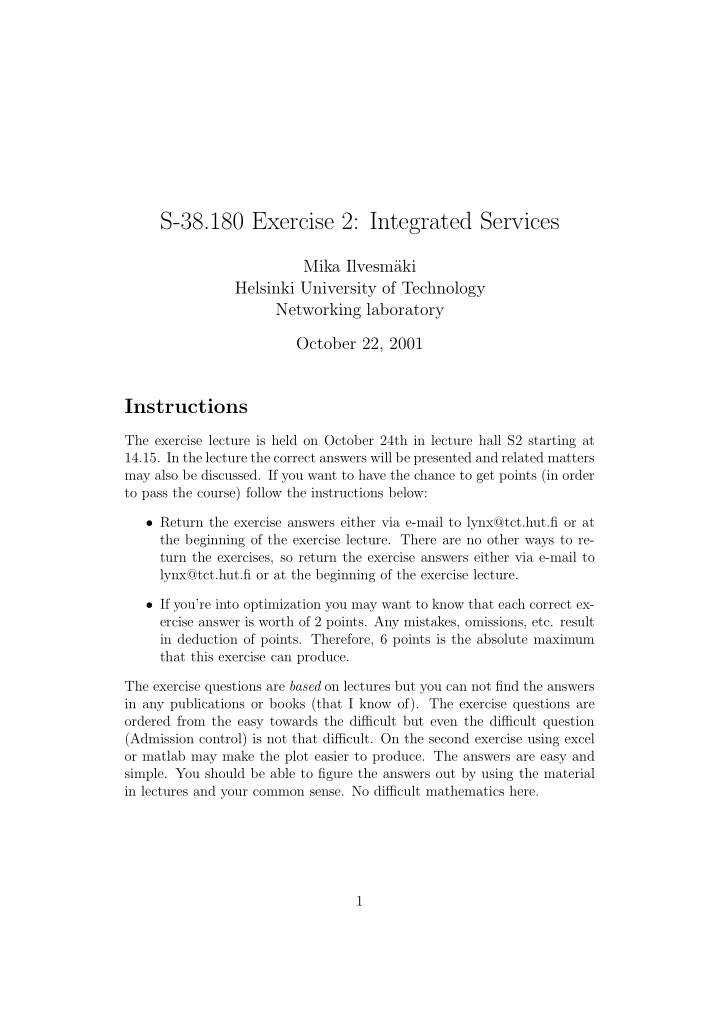



S-38.180 Exercise 2: Integrated Services Mika Ilvesm¨ aki Helsinki University of Technology Networking laboratory October 22, 2001 Instructions The exercise lecture is held on October 24th in lecture hall S2 starting at 14.15. In the lecture the correct answers will be presented and related matters may also be discussed. If you want to have the chance to get points (in order to pass the course) follow the instructions below: • Return the exercise answers either via e-mail to lynx@tct.hut.fi or at the beginning of the exercise lecture. There are no other ways to re- turn the exercises, so return the exercise answers either via e-mail to lynx@tct.hut.fi or at the beginning of the exercise lecture. • If you’re into optimization you may want to know that each correct ex- ercise answer is worth of 2 points. Any mistakes, omissions, etc. result in deduction of points. Therefore, 6 points is the absolute maximum that this exercise can produce. The exercise questions are based on lectures but you can not find the answers in any publications or books (that I know of). The exercise questions are ordered from the easy towards the difficult but even the difficult question (Admission control) is not that difficult. On the second exercise using excel or matlab may make the plot easier to produce. The answers are easy and simple. You should be able to figure the answers out by using the material in lectures and your common sense. No difficult mathematics here. 1
1 Scalability We assume that every reservation takes 1 kbyte of state space in an IntServ router. 1. We have 1000 multimedia conference sessions where each session re- serves about 1Mbps. How much bandwidth is needed on a link that has to carry all conference sessions? How much reservation space is needed in the IntServ router? 2. We have 30000 IP telephone sessions where each session reserves about 30Kbps. How much bandwidth is needed on a link that has to carry all IP calls? How much reservation space is needed in the IntServ router? Comment the results and suggest improvements if necessary. 1.1 Answers 1. We have 1000 multimedia conference sessions where each session re- serves about 1Mbps. How much bandwidth is needed on a link that has to carry all conference sessions? How much reservation space is needed in the IntServ router? Well, a session reserves 1 kbyte so 1000 sessions reserve 1 MB of state space (memory). The bandwdidth needed is 1 Gbps. 2. We have 30000 IP telephone sessions where each session reserves about 30Kbps. How much bandwidth is needed on a link that has to carry all IP calls? How much reservation space is needed in the IntServ router? The bandwidth requirement is approximately the same (30Kbps*30000 sessions takes roughly 1 Gbps of bandwidth) but the state space re- quirement is 30 MB. Comments may vary but you should notice that per-flow requirements call for huge amounts of memory. Especially in the core where reservation requests sum up. 2 Delay According to definitions in the textbook the end-to-end worst-case queuing b delay Q delay = R , when p → ∞ and R ≥ r . When p > R ≥ r then the end-to-end worst-case queuing delay is, b ( p − R ) R ( p − r ) . Plot both queuing delays as a function of R (service rate) when b = 14999bytes r = 14999bytes/s and p = 100kbytes/s. 2
2.1 Answer 1,2000 1,0000 0,8000 seconds R>=r 0,6000 p>R>=r 0,4000 0,2000 0,0000 1000 10000 20000 30000 40000 50000 60000 70000 80000 90000 100000 2000000 4000000 6000000 8000000 10000000 servicerate, R Figure 1: Delay as a function of the service rate 3 Admission control 1. Consider a scheduler that has three best-effort priority levels, roughly corresponding to email, FTP and HTTP. How many HTTP connections can be admitted if they require no minimum bandwidth? Can each email connection be guaranteed a bandwidth of at least 100 Kbps? How? 2. A link capacity of 155Mbps serves sources that have a peak rate of 15.5 Mbps and a peak-to-average ratio r . How many connections can be admitted with peak-rate allocation? How many connections can be admitted with average-rate allocation when taking into account the peak rate and and the peak-to-average ratio? 3
3.1 Answers 1. Consider a scheduler that has three best-effort priority levels, roughly corresponding to email, FTP and HTTP. How many HTTP connec- tions can be admitted if they require no minimum bandwidth? Can each email connection be guaranteed a bandwidth of at least 100 Kbps? How? We can admit as many HTTP connections as we want, since they do not require bandwidth reservations. We can guarantee the email connection a minimum bandwidth if highest best-effort priority level is guaranteed some minimum bandwidth and then email connections are allowed with this priority level. Link sharing is the alternetive option. 2. A link capacity of 155Mbps serves sources that have a peak rate of 15.5 Mbps and a peak-to-average ratio r . How many connections can be admitted with peak-rate allocation? How many connections can be ad- mitted with average-rate allocation when taking into account the peak rate and and the peak-to-average ratio? 155 Peak-rate allocation allows 15 . 5 = 10 sources to be admitted. With average-rate allocation the bandwidth requirement is 15 . 5 r for one source. 155 Therefore, = 10 r sources are admitted. 15 . 5 r 4
Recommend
More recommend